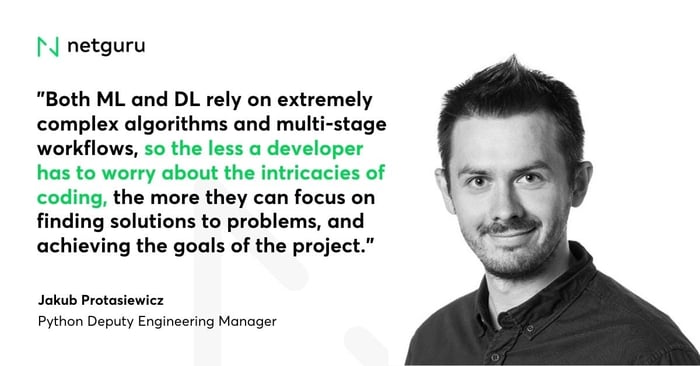Python AI: Why Is Python So Good for Machine Learning?

Favoured for applications ranging from web development to scripting and process automation, Python is quickly becoming the top choice among developers for artificial intelligence (AI), machine learning, and deep learning projects.
AI has created a world of opportunities for application developers. AI allows Spotify to recommend artists and songs to users, or Netflix to know what shows you’ll want to see next. It is also used extensively by companies in customer service to drive self-service, and improve workflows and employee productivity.
But what is it about Python that makes it so good for AI? In this article, we’ll take a look at the main reasons why Python is the go-to programming language for developers working in the fields of machine learning and deep learning and why you should consider it for your next AI project.
What is the difference between AI, machine learning, and deep learning?
Before we start, it might be helpful to understand the difference between AI, machine learning, and deep learning. In simple terms, deep learning is a subset of machine learning, and AI is the general category that contains machine learning.
AI is essentially any intelligence exhibited by a machine that leads to an optimal or suboptimal solution, given a problem. Machine learning then takes this a step further by using algorithms to parse data, and learn from it to make informed decisions.
Deep learning functions in a similar way, but has very different capabilities; namely the ability to draw conclusions in a manner that resembles human decision making. It does this by using a layered structure of algorithms inspired by the neural network of the human brain. The result, is a model that can learn multiple levels of representation that correspond to different levels of abstraction.
So what makes Python such a good choice for AI?
Python is favoured by developers for a whole host of applications, but what makes it a particularly good fit for projects involving AI? Let’s take a look.
Extensive selection of libraries and frameworks
One of the aspects that makes Python such a popular choice in general, is its abundance of libraries and frameworks that facilitate coding and save development time. Machine learning and deep learning are exceptionally well catered for.
NumPy, used for scientific computation, SciPy for advanced computation, and scikit-learn for data mining and data analysis, are among the most popular libraries, working alongside such heavy-hitting frameworks as TensorFlow, CNTK, and Apache Spark. In terms of machine learning and deep learning, these libraries and frameworks are in essence Python-first, while some, like PyTorch, are written specifically for Python.
The simplicity
Python is renowned for its concise, readable code, and is almost unrivaled when it comes to ease of use and simplicity, particularly for new developers. This has several advantages for machine learning and deep learning.

Python’s simple syntax means that it is also faster application in development than many programming languages, and allows the developer to quickly test algorithms without having to implement them.
In addition, easily readable code is invaluable for collaborative coding, or when machine learning or deep learning projects change hands between development teams. This is particularly true if a project contains a great deal of custom business logic or third party components.
Abundance of support
Python is an open-source programming language and is supported by a lot of resources and high-quality documentation. It also boasts a large and active community of developers willing to provide advice and assistance through all stages of the development process.
Wrapping up
AI is having a profound effect on the world we live in, with new applications emerging all the time. Smart developers are choosing Python as their go-to programming language for the myriad of benefits that make it particularly suitable for machine learning and deep learning projects.
Python’s extensive selection of machine learning-specific libraries and frameworks simplify the development process and cut development time. Python’s simple syntax and readability promote rapid testing of complex algorithms, and make the language accessible to non-programmers. It also reduces the cognitive overhead on developers, freeing up their mental resources so that they can concentrate on problem-solving and achieving project goals. Finally, the simple syntax makes it easier to collaborate or transfer projects between developers. Python also boasts a large, active community of developers who are happy to offer help and support, which can be invaluable when dealing with such complex projects.
While other programming languages can also be used in AI projects, there is no getting away from the fact that Python is at the cutting edge, and should be given significant consideration. This is why you should definitely consider Python for your AI project.









